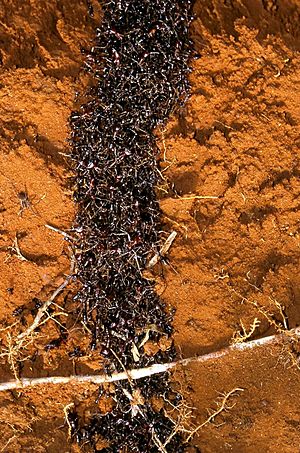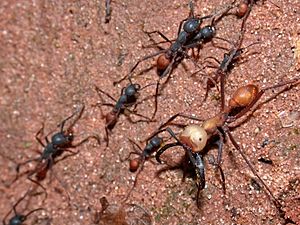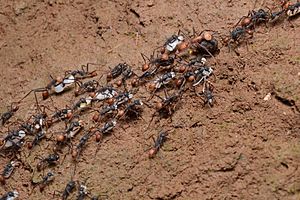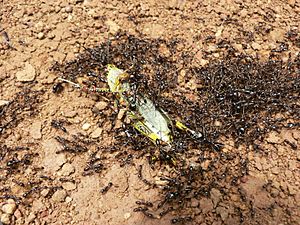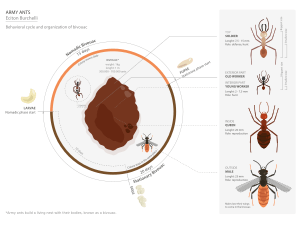Army ant facts for kids
Army ants are a special group of over 200 different ant species. People call them "army ants" because they hunt for food in huge, aggressive groups. These groups are like an "army" or "legion" that attacks other animals all at once.
Most ants build a permanent home and stay there. But army ants are different! They are always on the move. All army ant species belong to the ant family, called Formicidae. However, different types of army ants have developed this unique "legionary behavior" on their own. This is known as convergent evolution, where different species evolve similar traits.
Contents
What Army Ants Look Like
Worker Ants
Worker army ants are usually blind or have very simple eyes. Some species have different sizes and shapes of workers, each with a specific job. Other species have workers that all look the same. These worker ants are always sterile females, meaning they cannot have babies.
Soldier Ants
Soldier ants are bigger than worker ants. They have much larger and stronger jaws (mandibles). Older soldiers usually have bigger heads and stronger jaws than younger ones. Their main jobs are to protect the colony and help carry the heaviest food back to the nest.
Male Ants
Male army ants are quite large. They have a long, cylinder-shaped body and special jaws. They also have 13 segments on their antennae and have wings. Because they have wings, they can sometimes look like wasps. Male ants are born in special groups. As soon as they are ready, they fly off to find a queen to mate with. If a male finds an existing colony, the worker ants might even pull off his wings to let him into the nest for mating. Because of their size, male army ants are sometimes called "sausage flies" or "sausage ants."
Queen Ant
Real army ant colonies always have only one queen. She is blind and has a very large body. Army ant queens do not have wings. Their bodies are much bigger than worker ants, and they have 10 to 12 segments on their antennae. Queens can mate with many males. Because of her large body, a queen can lay 3 to 4 million eggs every month! This means a single queen can be the mother of millions of ants in her colony.
How Army Ants Behave
Army Ant Lifestyle
The "army ant lifestyle" describes their special ways of living. This includes how they hunt together, how they are always moving, and how their queens are very unique. These traits help them be some of the fiercest hunters in the insect world.
Most ants send out a few scouts to find food. Then, they call others to help. But army ants send out a huge group of foragers all at once. This group works together to find and overpower prey. Army ants do not have a permanent home. Instead, they form temporary nests called bivouacs as they travel. They move constantly because they need to hunt a lot of prey to feed their huge colony. Their queens do not have wings, and their bodies get very big when they lay eggs. This allows them to produce millions of eggs each month. All these traits are found in every army ant species.
Moving and Resting Phases
Army ants have two main phases of activity: a "nomadic" (wandering) phase and a "stationary" (resting) phase. These two phases cycle constantly.
The nomadic phase starts about 10 days after the queen lays her eggs. This phase lasts about 15 days while the larvae are growing. During the day, the ants move, catching insects, spiders, and small animals to feed their young. At night, they form their temporary nests, or bivouacs. They change their bivouac almost every day. At the end of this phase, the larvae spin cocoons and no longer need food.
The stationary phase lasts about two to three weeks. It begins when the larvae turn into pupae. During this time, the food that was going to the larvae now goes only to the queen. The queen's body swells up, and she lays her eggs. At the end of the stationary phase, the pupae come out of their cocoons. Also, the new eggs hatch, giving the colony new workers and larvae. After this, the ants start the nomadic phase again.
Colony Splitting
Army ants will split into new groups when their colony gets too big. This happens about every three years. New, wingless queens hatch along with male ants. When the colony splits, there are two ways new queens are chosen. One way is that a new queen stays at the old nest with some workers and the male ants. The old queen then leaves with the other workers to find a new nest. Another way is that the workers might reject the old queen. Then, new queens will lead the two new colonies. Workers choose which queen to follow based on special smells (pheromones) that each queen gives off. Once new bivouacs are formed, the old colony and the new ones stop communicating.
Queen's Importance
Army ant queens, like the African Dorylus queens, are some of the largest ants on Earth. They can lay millions of eggs each month. Army ant queens never have to leave the safety of their colony. They mate with male ants that fly in from other colonies. Scientists are still learning exactly how army ant queens mate. However, it seems they might mate with several males. Because the queen can lay so many eggs, an entire colony of millions of ants can be related to just one queen.
If the queen ant dies, there is no replacement. Army ants cannot create new queens in an emergency. Most of the time, if the queen dies, the colony will also die. A queen can be lost due to accidents, attacks from predators, old age, or sickness. However, there are ways for the colony to survive. If a colony loses its queen, the worker ants will often join another colony that has a queen within a few days. Sometimes, the workers will go back along their old paths to look for a lost queen. They might also join a related colony. By joining a new colony, the workers help their genes survive. Workers joining a new colony can make that colony grow by up to 50%.
Hunting for Food
A whole colony of army ants can eat up to 500,000 prey animals every day! This means they have a big impact on the number and types of animals in their area. What they eat depends on the army ant species.
Some species that live underground mostly eat arthropods (like insects and spiders) and their young. They also eat earthworms and sometimes even baby animals or turtle eggs. Many species, called "colony robbers," specialize in eating the young of other ants and wasps. Only a few species hunt a very wide range of prey. Even these species don't eat every kind of animal. For example, small animals caught in an American Eciton ant raid might be killed. However, the jaws of Eciton ants are not good for eating these larger animals. So, the unwanted prey are left behind for other scavengers to eat.
Most army ants hunt on the ground, looking for prey in leaf litter and low plants. About five species hunt in taller trees. There, they can attack birds and their eggs, but they mostly focus on hunting other social insects and their young. Army ant colonies are huge compared to other ant colonies. They can have over 15 million workers. During a raid, they can carry 3,000 food items per hour!
When army ants hunt, they form trails that can be over 20 meters wide and more than 100 meters long. They stay on the path by following a special scent called a pheromone. The scent is strongest in the middle of the trail. This splits the trail into different lanes. Ants leaving the nest use the outer lanes, and ants returning with food use the middle lane. The returning ants also release more pheromones, making the scent stronger in the middle. These pheromones help the ants hunt more efficiently. They avoid going over their own old paths or those of other ants.
As army ants hunt, they cause many small animals to run out of their hiding places. These places include under leaves, tree bark, and other spots on the forest floor. This makes it easier for other predators to catch them. For example, in the rainforests of Panama, large groups of army ants attract many types of birds. These birds come to feast on the insects, spiders, scorpions, and worms that the ants scare up. Some of these birds are even called "antbirds" because they follow army ants. When these birds are focused on eating, people can often get very close to them, sometimes within 1 or 2 meters. This is a great chance to see many bird species! Depending on the size of the ant group and how much prey they stir up, there can be a few birds or dozens. Birds that often follow army ants include the white-whiskered puffbird, rufous motmot, rufous-vented ground cuckoo, gray-necked wood rail, plain-brown woodcreeper, northern barred woodcreeper, cocoa woodcreeper, black-striped woodcreeper, fasciated antshrike, black-crowned antshrike, spotted antbird, bicolored antbird, ocellated antbird, chestnut-backed antbird, black-faced antthrush, and gray-headed tanager.
How Army Ants Nest
Army ants do not build a nest like most other ants. Instead, they build a living nest using their own bodies! This is called a bivouac. Bivouacs are often found inside tree trunks or in holes the ants have dug. The ants hold onto each other's legs to form a kind of ball. To a person, it might look messy, but it's actually a very organized structure. The older female workers are on the outside. The younger female workers are on the inside. If anything disturbs the bivouac, soldier ants quickly gather on the outside. They are ready to defend the nest with their strong jaws and, in some species, stingers. Inside the nest, there are many tunnels and chambers. These rooms hold food, the queen, the larvae, and the eggs.
See also
 In Spanish: Hormiga guerrera para niños
In Spanish: Hormiga guerrera para niños


